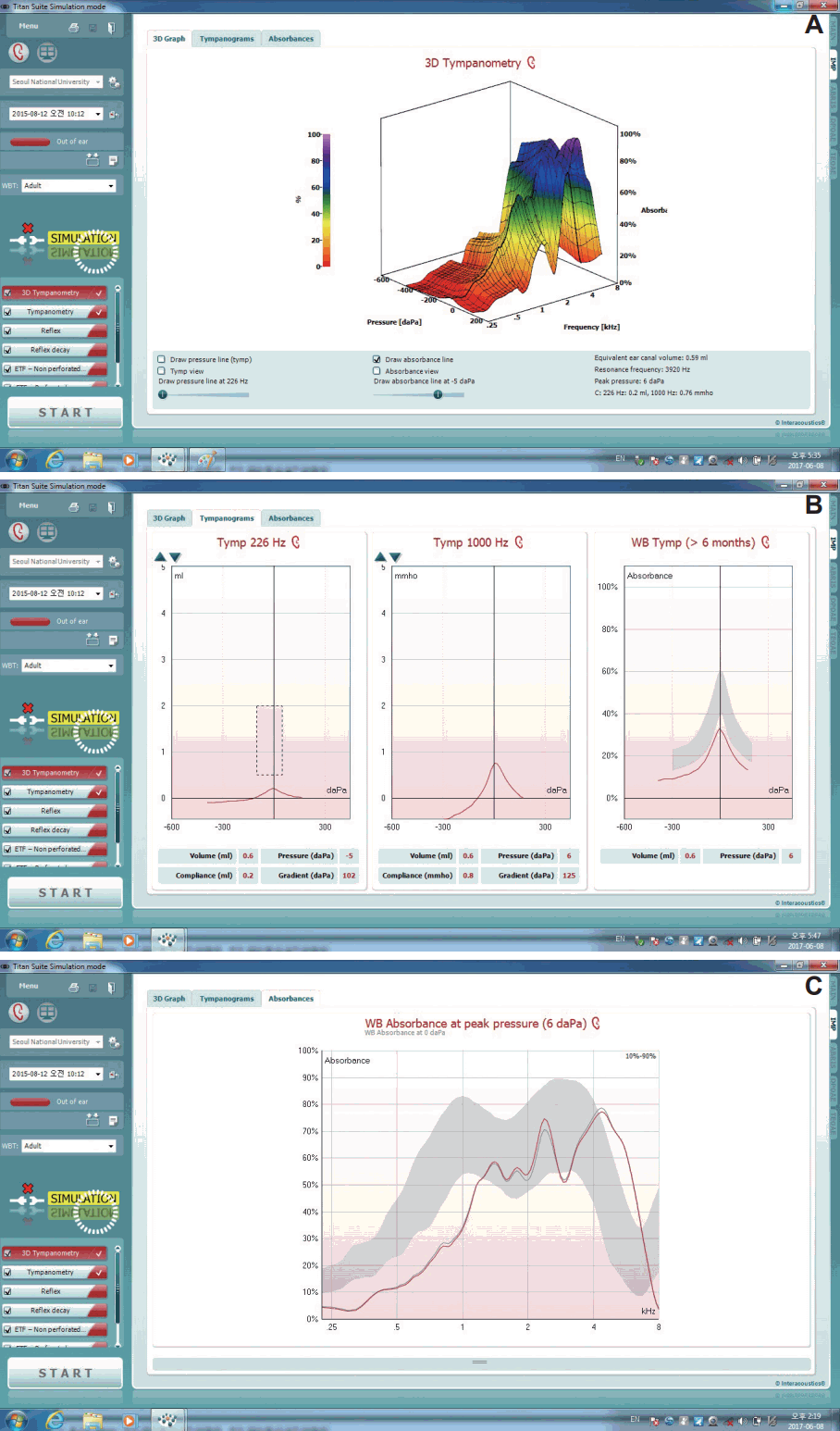1. Terkildsen K, Nielsen SS. An electroacoustic impedance measuring bridge for clinical use. Arch Otolaryngol. 1960; 72:339–46.

2. Van Camp KJ, Margolis RH, Wilson RH, Creten WL, Shanks JE. Principles of tympanometry. ASHA Monogr. 1986; (24):1–88.
3. Nozza RJ, Bluestone CD, Kardatzke D, Bachman R. Identification of middle ear effusion by aural acoustic admittance and otoscopy. Ear Hear. 1994; 15(4):310–23.

4. Liu Z, Liu L, Yang K. [Comparison between 226 Hz probe tone tympanometry and spiral CT test in infants]. Lin Chung Er Bi Yan Hou Tou Jing Wai Ke Za Zhi. 2012; 26(19):887–9.
5. Baldwin M. Choice of probe tone and classification of trace patterns in tympanometry undertaken in early infancy. Int J Audiol. 2006; 45(7):417–27.

6. Park M, Han KH, Jung H, Kim MH, Chang HK, Kim SH, et al. Usefulness of 1000-Hz probe tone in tympanometry according to age in Korean infants. Int J Pediatr Otorhinolaryngol. 2015; 79(1):42–6.

7. Jerger J, Anthony L, Jerger S, Mauldin L. Studies in impedance audiometry. 3. Middle ear disorders. Arch Otolaryngol. 1974; 99(3):165–71.
8. Shahnaz N, Polka L. Standard and multifrequency tympanometry in normal and otosclerotic ears. Ear Hear. 1997; 18(4):326–41.

9. Funasaka S, Kumakawa K. Tympanometry using a sweep-frequency probe tone and its clinical evaluation. Audiology. 1988; 27(2):99–108.

10. Keefe DH, Bulen JC, Arehart KH, Burns EM. Ear-canal impedance and reflection coefficient in human infants and adults. J Acoust Soc Am. 1993; 94(5):2617–38.

11. Voss SE, Allen JB. Measurement of acoustic impedance and reflectance in the human ear canal. J Acoust Soc Am. 1994; 95(1):372–84.

12. Shahnaz N, Miranda T, Polka L. Multifrequency tympanometry in neonatal intensive care unit and well babies. J Am Acad Audiol. 2008; 19(5):392–418.

13. Terzi S, Özgür A, Erdivanli ÖÇ, Coşkun ZÖ, Ogurlu M, Demirci M, et al. Diagnostic value of the wideband acoustic absorbance test in middle-ear effusion. J Laryngol Otol. 2015; 129(11):1078–84.

14. Aithal S, Kei J, Driscoll C, Khan A, Swanston A. Wideband absorbance outcomes in newborns: a comparison with high-frequency tympanometry, automated brainstem response, and transient evoked and distortion product otoacoustic emissions. Ear Hear. 2015; 36(5):e237–50.
15. Feeney MP, Hunter LL, Kei J, Lilly DJ, Margolis RH, Nakajima HH, et al. Consensus statement: Eriksholm workshop on wideband absorbance measures of the middle ear. Ear Hear. 2013; 34 Suppl 1:78S–9S.
16. Mazlan R, Kei J, Ya CL, Yusof WN, Saim L, Zhao F. Age and gender effects on wideband absorbance in adults with normal outer and middle ear function. J Speech Lang Hear Res. 2015; 58(4):1377–86.

17. Shahnaz N, Feeney MP, Schairer KS. Wideband acoustic immittance normative data: ethnicity, gender, aging, and instrumentation. Ear Hear. 2013; 34 Suppl 1:27S–35S.
18. Aithal S, Kei J, Driscoll C. Wideband absorbance in Australian Aboriginal and Caucasian neonates. J Am Acad Audiol. 2014; 25(5):482–94.

19. Voss SE, Stenfelt S, Neely ST, Rosowski JJ. Factors that introduce intrasubject variability into ear-canal absorbance measurements. Ear Hear. 2013; 34 Suppl 1:60S–4S.

20. Aithal S, Kei J, Driscoll C. Wideband absorbance in young infants (0-6 months): a cross-sectional study. J Am Acad Audiol. 2014; 25(5):471–81.

21. Özgür A, Müjdeci B, Terzi S, Özergin Coşkun Z, Yiğit E, Dursun E. Wideband tympanometry normative data for different age groups in Turkish population. J Int Adv Otol. 2016; 12(1):82–6.
22. Aithal S, Kei J, Aithal V, Manuel A, Myers J, Driscoll C, et al. Normative study of wideband acoustic immittance measures in newborn infants. J Speech Lang Hear Res. 2017; 60(5):1417–26.

23. Polat Z, Baş B, Hayır D, Bulut E, Ataş A. Wideband tympanometry normative data for Turkish young adult population. J Int Adv Otol. 2015; 11(2):157–62.

24. Feeney MP, Stover B, Keefe DH, Garinis AC, Day JE, Seixas N. Sources of variability in wideband energy reflectance measurements in adults. J Am Acad Audiol. 2014; 25(5):449–61.

25. Sun XM. Wideband acoustic immittance: normative study and test-retest reliability of tympanometric measurements in adults. J Speech Lang Hear Res. 2016; 59(4):819–34.

26. Keefe DH, Hunter LL, Feeney MP, Fitzpatrick DF. Procedures for ambient-pressure and tympanometric tests of aural acoustic reflectance and admittance in human infants and adults. J Acoust Soc Am. 2015; 138(6):3625–53.
27. Ryu G, Cho YS. Wideband absorbance measurements: norms and middle ear disorders. Korean J Otorhinolaryngol-Head Neck Surg. 2017; 60(2):55–62.

28. Shahnaz N, Bork K, Polka L, Longridge N, Bell D, Westerberg BD. Energy reflectance and tympanometry in normal and otosclerotic ears. Ear Hear. 2009; 30(2):219–33.

29. Beers AN, Shahnaz N, Westerberg BD, Kozak FK. Wideband reflectance in normal Caucasian and Chinese school-aged children and in children with otitis media with effusion. Ear Hear. 2010; 31(2):221–33.

30. Feeney MP, Grant IL, Marryott LP. Wideband energy reflectance measurements in adults with middle-ear disorders. J Speech Lang Hear Res. 2003; 46(4):901–11.

31. Guan X, Seale TW, Gan RZ. Factors affecting sound energy absorbance in acute otitis media model of chinchilla. Hear Res. 2017; 350:22–31.

32. Keefe DH, Fitzpatrick D, Liu YW, Sanford CA, Gorga MP. Wideband acoustic-reflex test in a test battery to predict middle-ear dysfunction. Hear Res. 2010; 263(1-2):52–65.

33. Voss SE, Herrmann BS, Horton NJ, Amadei EA, Kujawa SG. Reflectance measures from infant ears with normal hearing and transient conductive hearing loss. Ear Hear. 2016; 37(5):560–71.

34. Nakajima HH, Rosowski JJ, Shahnaz N, Voss SE. Assessment of ear disorders using power reflectance. Ear Hear. 2013; 34 Suppl 1:48S–53S.

35. Pitaro J, Al Masaoudi L, Motallebzadeh H, Funnell WR, Daniel SJ. Wideband reflectance measurements in newborns: relationship to otoscopic findings. Int J Pediatr Otorhinolaryngol. 2016; 86:156–60.

36. Soares JC, Urosas JG, Calarga KS, Pichelli TS, Limongi SC, Shahnaz N, et al. Wideband reflectance in Down syndrome. Int J Pediatr Otorhinolaryngol. 2016; 87:164–71.

37. Pucci BPC, Roque NMCF, Gamero MS, Durante AS. Acoustic absorbance measurements in neonates exposed to smoking during pregnancy. Int J Pediatr Otorhinolaryngol. 2017; 95:51–6.

38. Voss SE, Adegoke MF, Horton NJ, Sheth KN, Rosand J, Shera CA. Posture systematically alters ear-canal reflectance and DPOAE properties. Hear Res. 2010; 263(1-2):43–51.






 PDF
PDF Citation
Citation Print
Print


 XML Download
XML Download